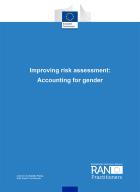Details
- Publication date
- 27 May 2024
- Author
- Directorate-General for Migration and Home Affairs
- RAN Publications Topic
- Deradicalisation/disengagement and exit work
- Evaluation
Description
Risk assessment tools developed specifically for violent extremist offenders (VEOs) currently lack an explicit gender dimension. Practice and research suggest that such a dimension is necessary. Importantly, the implications are relevant not only for the risk assessment itself, but also in the broader context of violent extremism (VE) management. For example, a recent United Nations Office on Drugs and Crime (UNODC) specialised handbook focused on gender observes:
Risk assessment tools are most often developed for male offenders, without taking into account the gender-specific needs of women – an omission which frequently results in women being placed in higher security settings than appropriate to the level of risk they represent.
Why should gender be a consideration in risk assessment? Before addressing this question, it is important to differentiate between two main aspects of our underlying understanding of gender: ‘women’ and ‘gender roles’. These dimensions point to the distinct nature of women’s radicalisation, and it is assumed that these specific features are relevant to risk assessment, rehabilitation, and reintegration. It follows that they should also be captured in risk assessment tools. Secondly, it is assumed that risk factors might also be influenced by the way in which gender roles are portrayed in extremist propaganda, since they might influence motivation and behaviour more broadly.
From a practical perspective, if the aspects reflecting women’s particular experiences and gender roles are not operationalised, there is a risk of carrying out biased assessments. One such example is that of false negatives: when women are erroneously considered less dangerous than men, or when tasks performed by women are assessed as less relevant to their given degree of radicalisation. False positives can also occur, such as when men are considered more high-risk due to taking on typical masculine roles (such as carrying a weapon or having fought), while their actual or cognitive radicalisation is superficial, or they have since effectively disengaged.
The usual approach to risk assessment in the field of VE is structured professional judgement (SPJ), currently considered to be “the best approach for the assessment of VEOs”. Compared to actuarial tools, SPJ tools do not provide a risk score automatically, based on mathematical computations, but are instead largely based on assessment and draw on the assessor’s expertise.

